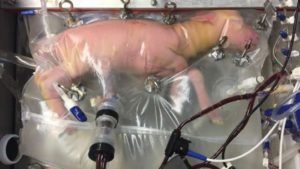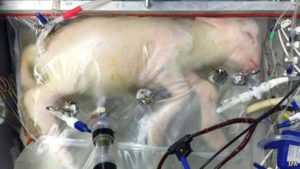To save children born prematurely, experimenting with a a man-made uterus
9 July 2017 – Now is a perplexing time to be thinking about how technology shapes us. We readily imagine cracking the secrets of artificial life, and downloading and uploading a human mind. Others believe that exponential growth in computing power is about to unlock something special. Economists Erik Brynjolfsson and Andrew McAfee write of “the second machine age”, while the World Economic Forum’s Klaus Schwab favors the term “fourth industrial revolution”, following the upheavals of steam, electricity and computers.
This coming revolution, they say, will be built on advances in artificial intelligence, robotics, virtual reality, nanotech, biotech, neurotech and a variety of other fields currently exciting venture capitalists.
But history always teaches us something useful: not to fixate on the idea of “the next big thing”, but the many small, isolated technological miracles that utterly transform some part of the daily fabric of life, sometimes with barely a ripple elsewhere.
One of the wonderful bits about summer holiday is being able to catch-up on my science readings. And that is where I find those small (and not so small) technological miracles … reading my back-issues of Nature magazine and Nautilus magazine, my two favorite “long read” science publications. And my wife has aided my quest. This year she bought me the new Kartoa book/sport bag, a bag originally designed for the gym but now modified as a carry-on bag/travel bag with a port to stuff a stash of books and magazines, with a top zipper insulated compartment to easily lay my MacBook and iPad (and swiftly remove them for security checks at airports). And keeping the second port for shoes, gym clothes, tech rechargers, whatever.
On to the man-made uterus …..
Astounding fact: these days, in rich countries, premature birth is the main cause of infant mortality. A baby born at 23 weeks — just over half way through a normal pregnancy — has a fighting chance of survival. But underdeveloped lungs struggle to cope with breathing air. External pumps used to circulate blood impose potentially fatal stresses on tiny hearts. Those that do pull through are often left with lifelong problems that range from brain damage to blindness. In a paper published in Nature back in April, a team of doctors at the Children’s Hospital of Philadelphia described an artificial womb that, they hope, could improve things dramatically, boosting the survival rate of the most premature babies while reducing the chance of lasting disabilities.
The device … which looks a bit like a high-tech jiffy bag … is designed to mimic a real womb as closely as possible (see pictures above, of a lamb fetus after 28 days in the artificial womb). The fetus is surrounded in a substitute for the amniotic fluid that keeps the animal’s lungs filled with liquid in a real uterus. Once the fetus is placed inside the bag it is sealed, to prevent germs entering. The cannulas which carry blood away to be recharged with oxygen and nutrients are inserted into the animal’s umbilical cord, and the tubing in the oxygen-exchange system is short, which lets the researchers dispense with pumps entirely. Instead, they rely on the animal’s own heart to push blood around the system.
The results are impressive. The artificial womb kept premature lambs alive for four weeks, which is longer than any previous attempt.
NOTE: the researchers say they could have carried on for longer still, had their trial protocols not forbidden it. A protocol is a complex document. It describes how a clinical trial will be conducted … the objective(s), the design, the methodology, the statistical considerations and the organization of a clinical trial. It ensures the safety of the trial subjects and integrity of the data collected. I wrote to Nature to try and obtain the protocol in this case.
I was able to find out via a separate source that the lambs developed normally, growing wool and moving around as they would in a natural womb. When the team subsequently dissected them, they found no evidence of the strokes that sometimes afflict premature babies in conventional incubators.
The aim of this effort is to produce a system that could help human babies born at 23 weeks, which is currently the lower limit of viability (between a third and half of such babies survive, and even that requires heroic efforts).
It will be a while, though, before the technology arrives in hospitals. For one thing, the parallels between sheep and people are not perfect. Human fetuses at a similar stage of gestation are only about a third of the size of lambs, so the equipment will have to be shrunk commensurately. And any procedure applied to such delicate patients will require a lot of proving before regulators give the go-ahead. Treating mothers at risk of premature birth with steroids, for instance, helps prepare their babies’ lungs for breathing air, and is now routine. But it took more than 20 years of tests and research before that discovery was deemed robust enough to make its way into hospitals.
However, the team is now in discussions with the U.S. Food and Drug Administration and predicts that babies could be incubated in the system within three years in the first clinical trial. The human version will have the appearance of a fluid-filled incubator, with a dark cover and interior, and the baby would be monitored by cameras. The team predicts that such a set-up, while unfamiliar, is likely to be less distressing for parents than the current situation in which fragile infants typically undergo a host of invasive procedures, including intubation, ventilation and surgery.
And in an interview in The Guardian the authors also ruled out the prospect of an entire gestation taking place externally, as depicted in Aldous Huxley’s Brave New World, where babies are routinely “decanted” into the world from artificial wombs: “There is no such technology on the horizon. There’s nothing but the mother that’s able to support that initial period of time.”



